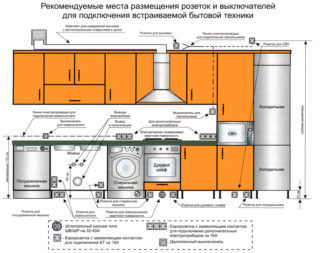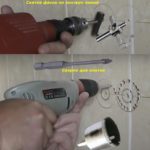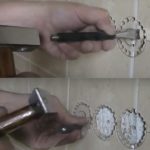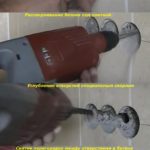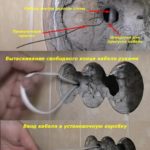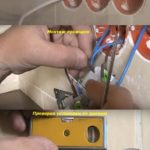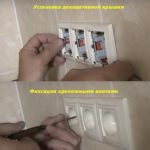The kitchen is the busiest space in terms of electricity consumption. The hostess has at her disposal an extensive arsenal of household appliances and various appliances. On the one hand, it is very convenient, on the other hand, the load on the line increases, many sockets are required. It is easier to entrust the preparation of the project and installation of the wiring to professionals, but this is expensive, and you still need to find a good specialist - there is a risk of running into an illiterate worker. You can install the sockets on the kitchen apron yourself. To do this, you need to familiarize yourself with the features of the calculations, installation rules and safety measures.
- Points to consider when placing outlets
- Determining the number of nests
- Location rules
- Height of sockets on the kitchen panel
- Preparing for installation
- How to make an outlet on a kitchen apron
- How to cut a hole for an outlet on a kitchen apron
- Step-by-step connection algorithm
- Additional recommendations
- Common mistakes
Points to consider when placing outlets
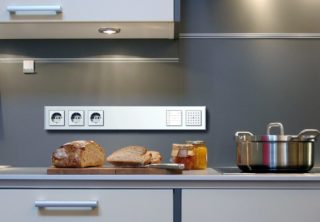
Outlet layouts provided by typical projects do not fit modern kitchen interiors. While the energy sources are anchored in the side walls, the bulk of consumers are in the countertop area. Powerful household appliances are installed in the same row with the cabinets and inside them, and on top there are no less powerful appliances.
When drawing up a wiring diagram for electrical equipment, it is necessary to take into account the following nuances:
- At the initial stage of installation, a three-core cable should be laid, even if grounding is not provided. Subsequently, this defect can be eliminated. Then you don't have to change the wiring.
- When choosing a power cable, you need to stop at the maximum power consumption when several consumers are connected to one block.
- The sockets on the kitchen apron should be located at such a distance so as not to move the appliances on the tabletop when it becomes necessary to connect them to the network.
When choosing outlets, it is better to opt for splash-proof options. This will prevent moisture from entering the terminals.
Determining the number of nests

When determining the required number of outlets in a kitchen apron, you need to use simple mathematical rules.
The required indicator will consist of the following terms:
- Devices that are constantly connected: stove, microwave oven, coffee maker, extractor hood, lamp, kettle.
- Devices used as needed: washing machine, dishwasher, bread maker, multicooker, toaster, food processor, coffee grinder.
- Reserve. It is provided for connecting a soldering iron, vacuum cleaner or other products for occasional work.
Avoid making multiple jacks for each device you have, as this will result in unnecessary expense and clutter up your headset. The best option is to have sockets at maximum kitchen load plus 1-2 backup entrances. It is better to have a small margin, since after installation it will not be possible to change anything, and the use of extension cords and tees is not the best solution.
Location rules
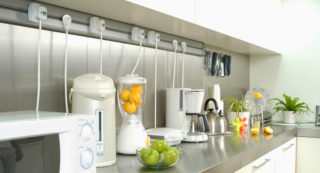
When drawing up a scheme for installing sockets on an apron, you need to be guided not only by practicality, beauty and design. The main focus should be on security issues.
The following rules should be adhered to:
- You need to fix the pads at a distance of at least 5 cm from the table top. This will prevent them from getting wet if accidentally spilled.
- Do not install switches and sockets above the sink and stove. This can cause short circuits or melting of the products.
- The sockets should be placed symmetrically, at the same height and distance from each other. This approach reduces material costs and allows you to know exactly where the hidden wiring is going.
- The distance to any device should not be more than 100 cm. From stationary devices, sockets should be at a distance of the length of their standard cable minus 20 cm.
Since work in the kitchen is associated with fatty fumes, it is advisable to choose pads with covers that protect the terminals from contamination.
Height of sockets on the kitchen panel
When composing an electrical layout, you should adhere to the following recommendations:
- According to SNiP, the maximum height of the sockets from the floor should not exceed 200 cm. If the installation of intermediate devices of a hidden type is carried out, they should not be closer than 30 cm from the plinth. At this level, water and drain pipes are laid, their breakage can cause a short circuit.
- If there are large household appliances on the countertop, the shoe should not be attached directly behind it. This will cause the device to protrude beyond the edge of the work surface.
- When installing sockets in the kitchen on an apron, it is advisable to adhere to a height of 100 cm from the floor. This corresponds to SNiP and is convenient for the hostess.
- Do not lift sockets under wall cabinets. If they are placed high, such a solution will lead to a loss of aesthetics, since all the wires coming from the devices will be visible. It is better to stop at the level of 15-25 cm. So the sockets can be disguised behind one of the small devices.
If you plan to install massive household appliances on the countertop, the block should be raised above it by 5-10 cm so as not to remove the heavy thing to connect other appliances.
Preparing for installation
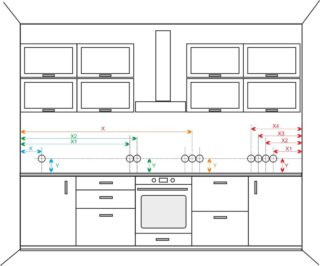
The beginning of the kitchen electrification process is drawing up a project, making calculations and purchasing everything you need.
To work, you will need the following tools and materials:
- puncher, grinder, soldering iron;
- pliers, wire cutters, knife;
- screwdrivers;
- roulette, level;
- copper cable VVGng-Ls 3x4mm²;
- putty knife, putty;
- corrugated plastic tube.
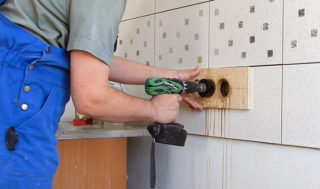
The preparation of the base is carried out in the following sequence:
- Marking is applied to the walls. Lines are drawn only in the vertical and horizontal direction. The places where the sockets and mounting boxes will be located are marked.
- With the help of a grinder and a perforator, strobes and holes for glasses are made.
- Plastic tubes are placed in the grooves with a cable pre-stretched inside. After that, the grooves are sealed with putty.
You can continue working after the solution has completely set. To avoid subsequent stripping, the mortar must be laid so that it does not form a convex layer after hardening.
How to make an outlet on a kitchen apron
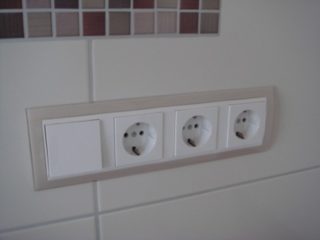
Depending on the style and design of the kitchen, the socket on the apron can be internal or overhead. The choice depends on the material of the walls, the size of the room and the priorities of the hostess.
To make an internal socket, it is necessary to make a hole before installing the panel and brick the sleeve in it. After that, a block with terminals and contacts is fixed in it. To put the outer cover in the apron, a hole is made in the shape of the terminals.
The standard for mounting overhead products is to pre-mount a bracket in the wall to fix the case. For this, a wooden block is used, fixed in a niche. For fixing the socket, 3 holes are made - for cable outlet and self-tapping screws.
Indoor installation is the best option. So the products will not protrude above the table top, and appliances and fixtures can be placed right next to the wall.
How to cut a hole for an outlet on a kitchen apron
It is easiest to make holes in MDF. For this, a sharp knife, manual or electric jigsaw is used. After cutting, the edges must be treated with any sealing substance to protect them from moisture.
Holes in ceramic tiles can be made with a diamond core bit, hand cutter or string after pre-drilling the contour.
Glass is the hardest part to work with. It is almost impossible to make a hole in a hardened material on your own. It is advisable to include this procedure in the order for the manufacture of an apron at the company. To do this, it is necessary to accurately measure and calculate everything in order to achieve complete coincidence of the holes and wires.
Step-by-step connection algorithm
Installation of sockets on the kitchen panel is carried out in the following sequence.
- The cable cores are stripped and soldered with tin.
- The ends of the cable are inserted into the junction boxes and contacts of the strips. Their tightening is carried out. The quality of the contacts is checked by pulling the wires.
- The block is fixed. It is fixed in the glass by screwing in the bolts that adjust the position of the legs. To make sure that the block is securely fastened, you need to insert the plug into the terminals several times and pull it out.
- The outer cover is attached. The room is de-energized, the cable is connected to the network.
Before turning on the voltage, you need to visually inspect the circuit again to exclude the possibility of a short circuit.
Additional recommendations
During operation, the sockets can overheat, which leads to oxidation of contacts and terminals, burning of cores. In order not to turn off the entire apartment for the period of renovation, it is advisable to equip the line with its own 16-25A burst switch. This device will prevent the possibility of a short circuit.
A good solution is to install switches with hidden wiring to control low-power appliances - a cooker hood, lamp, toaster, multicooker.
When installing outlets, you need to choose the place that is most convenient for use and corresponding to safety rules. It is advisable to choose such a height of installation of devices that they provide the maximum comfort of their use in a wide variety of situations. If the kitchen has a large area, the energy sources must be installed at intervals of no more than 100 cm. This will provide the hostess with complete freedom of action.
Common mistakes
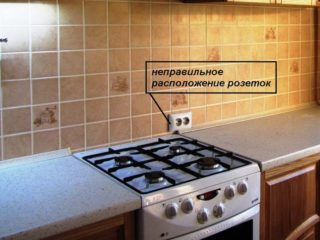
In the process of design and installation, inexperienced craftsmen make the following mistakes:
- Design errors. After installing the furniture, the sockets are behind cabinets and large household appliances.
- Savings on the cable, which leads to overheating and melting of the insulation.
- Connection of washing and flowing devices through simple machines.
- Incorrect placement of the sockets (above the sink and stove, close to the gas pipes).
- Placing the cable in the grooves without the use of plastic tubes.
Observing the technology of work and using high-quality materials, you can easily make a reliable and durable wiring on the apron.

